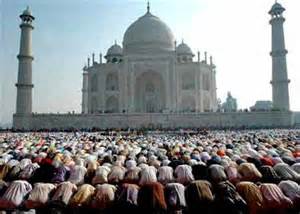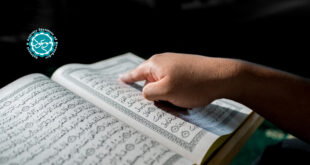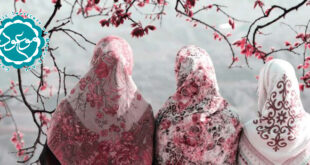Khwaja Moinuddin Hasan Chishti, who brought the Chishtiyya order to India and he is considered as the most outstanding Sufi saint in India and famous as Sultan-i-Hind. The Dargah Sharif of Khwaja Moinuddin Chishti, is one of the most holy places for Muslims. The Dargah is equally holy for Hindus and other religion followers. Khwaja was also called as Gharib Nawaj, which means the protector of the poor. The shrine is equally prayed by Hindus. People have faith that any wish asked with pure heart will be fulfilled by Khwaja.
The ‘urs is a yearly celebration of the death date of a Sufi saint. About 16 days after Id-ul-fitr, many Muslims and some non-Muslims in and around Delhi take part in another festive occasion they call the Satrahvin Sharif – literally Holy Seventeenth. This is the Urs or death anniversary of Hazrat Amir Khusrau, the favourite companion of 12th century Sufi saint Nizamuddin Aulia. Thousands of people throng the twin Dargah (tomb) and offer their nazrana (of flowers, chadurs and sweets), say the fatehas (oblation), tie threads of mannat (vow) on the tomb’s jali, or just sit there listening to ecstatic qawwalis. There is also Charaghan (illumination with lamps) inside the tomb, and outside, everyone makes merry in a colorful fete, which goes on for three to four days. (5)
There are hundreds of Sufi saints in India whose tombs become center of such occasions at least once every year, yet the legend of Amir Khusrau and Nizamuddin Aulia is something special in the history of Indian Sufism. Amir Khusrau, according to the popular belief, was a steadfast Sufi and the most favorite disciple of Nizamuddin Aulia. For last seven centuries, every year the Urs of both saints is celebrated with a gap of exactly six months – Nizamuddin Aulia’a Urs too being called the Satrahvin Sharif. (6)
The Urs of Syed Salar Masud or Ghazi Miyan in Bahraich which took place on the first Sunday in the month of Jeth (May/June) hundred of thousands of Muslims and Hindus participate in it. The Mir Datar Dargah at Unava, about hundred kilometers north of Ahmadabad, near the district town of Mehsana in Gujrat state also attract thousands of Hindu pilgrims.
Some dargahs maintain public kitchens which distribute free food (langar) to the poor and to the travelers. The langar is also the essential feature of the annual urs celebration
The Rich Tradition of Syncretism in India
In most part of south India, the Muslims and non-Muslims cannot be distinguished by the dress or language. But the Muslims preserve their Islamic identity by observing the Islamic rituals and customs. In the era of Islamic practices they are the staunch practicing Muslims but Islam is the basis of inter-faith understanding in these regions.
India has a long and rich tradition of syncretism or the fusion of different forms of beliefs and practices. Religions liberally borrowed each others rituals, customs and to some extent beliefs. In India, even Islam with their strict monotheism was not immune to this trend.
The Shrine of Ayappa in the Sabari Mala Mountains of Kerala attracts thirty million devotees each year. Ayappa reportedly had a Muslim disciple called Wavar who led an army of warriors and defeated Ayappa’s enemies. There still exists a mosque called Wavar Masjid at the foot of the hill where pilgrims seek the blessings from a “maulvi” before embarking on the uphill trek.
Arguably, the most popular cult in India is that of the Sai Baba of Shirdi. His portraits and popular saying, Sab Ka Malik Aik (Everyone’s lord is one), are ubiquitous among the Hindus in India, gracing everything from plush offices to auto-rickshaws.
His clothing, actions and many popular sayings and actions definitely point that he was a Muslim fakir. He wore the dress of Muslim fakir, held ‘fatiha’ ceremony every Thursday and lived and died in a mosque in Shirdi.’ During his life he was simply known as a Muslim fakir.
Haji Baba Ratan of Bhatinda in Punjab is greatly revered. Hindus, Muslims and Sikhs all claim him to be their own despite his strong Muslim connections. Hindu ladies still line up at the doors of several mosques in India and ask the Muslim men leaving after the prayers to blow on their children. (7)
India’s medieval arts do not know religious or communal boundaries. Hindu and Muslim elements join together to build a Masjid or a temple, and Imambara or a Gurudwara, the darbar of a Sultan or the palace of a Raja, with equal coordination and without distinction. The same forms and features of miniature painting serve to depict and illustrate the scenes of love adventures of Ram and Sita, Radha and Krishna, Shiva and Parvati, or of Layla and Majnun, Khusrow and Shirin, Yusuf and Zulaykha; and the same tunes and melodies go with the songs that sing the joys and the sorrows of a Hindu singer or a Muslim poet. (8)
Hinduism allows a Hindu to pay respect to Jesus Christ in the churches, pray and seek assistance from Muslim saints in darhahs and Imambadas or visit Sikh Gurudwaras. (9)
The synthesis in the field of religion has often been noticed and does not require elaborate description. It is enough to say that both from the Muslim and from the Hindu points of view, there was an attempt at rapprochement. The lives of men like Kabir Guru Nanak, Ramananda, Dadu and others offer unmistakable testimony to this fact. The similarities between Sufism and Vaisnavism have often been noticed and need not be stressed. Their affinity must have contributed to the popularity of Sufi saints in India. (10)
Conclusion
The Muslims in India which comprise the largest religious minority in India has experienced a massive growth of Islamic popular culture in the form of calendar prints and souvenirs, which is absorbed into the living religious practices of Islam in India.
Thus, the religious symbols of Hinduism, Buddhism, Jainism, Sikhism, Judaism, Zoroastrianism, Christianity, and Islam have played a very important role in the national integration and interfaith understanding of modern India.
Notes:
1- Nigam, Mohanlal; Indian Ashur Khanas”, Red Sand, New Delhi, 1984, pp.118-120
2- Dr. Sadiq Naqvi, Muslim Religious Institutions and their Role under the Qutb Shahs, Hyderabad, 1993, pp.169-175
3- Rashida Moosavi; Deccan Mee Marsiya Aur Azadari , Hyderabad, 1978, p.57
4- Sayyed Athar Abbas Rizvi, History of Sufism in India, Volume 2, New Delhi, 1992, p. 178
5- Imtiaz Ahmad, Rituals and Religion among Muslims in India, New Delhi, 1984, pp, 174-176
6- Ibid, pp, 191-193
7- Culture India, p. 210
8- Ibid, pp. 126-127
9- Rituals and Religion among Muslims in India, pp, 91-92
Culture India, p. 148
 Mouood Mouood English Edition
Mouood Mouood English Edition




